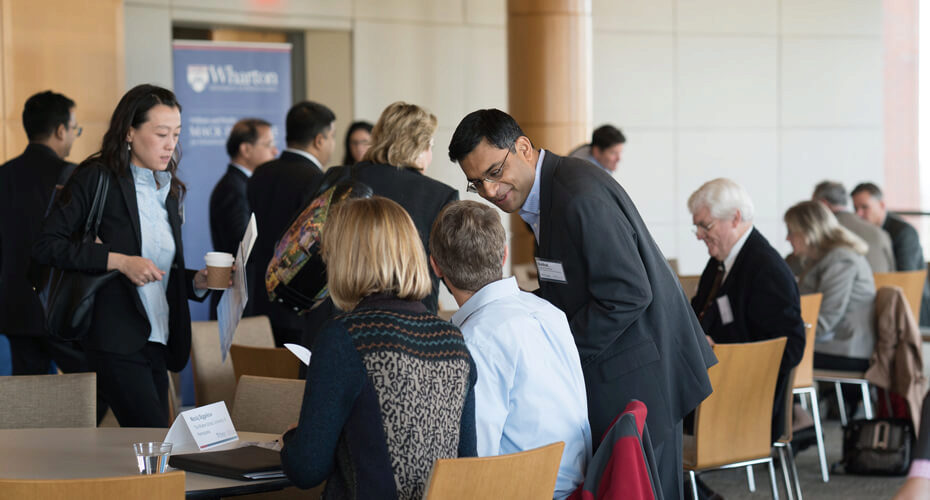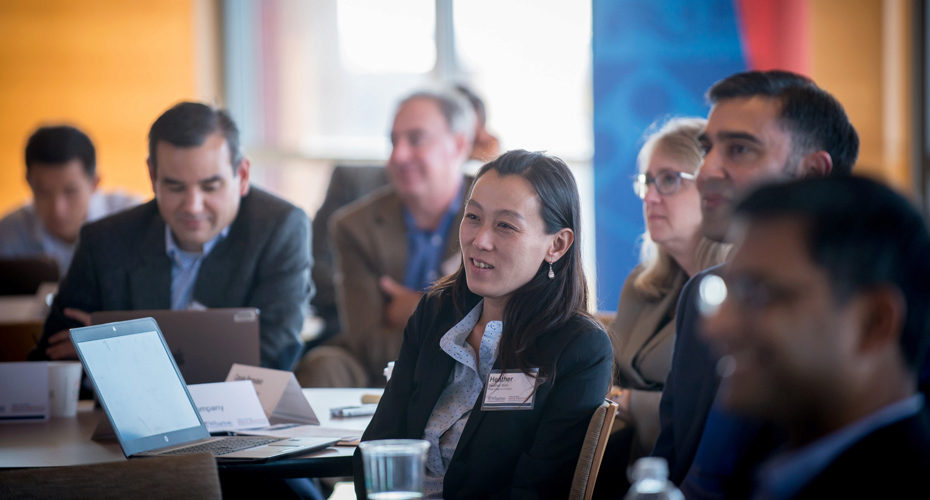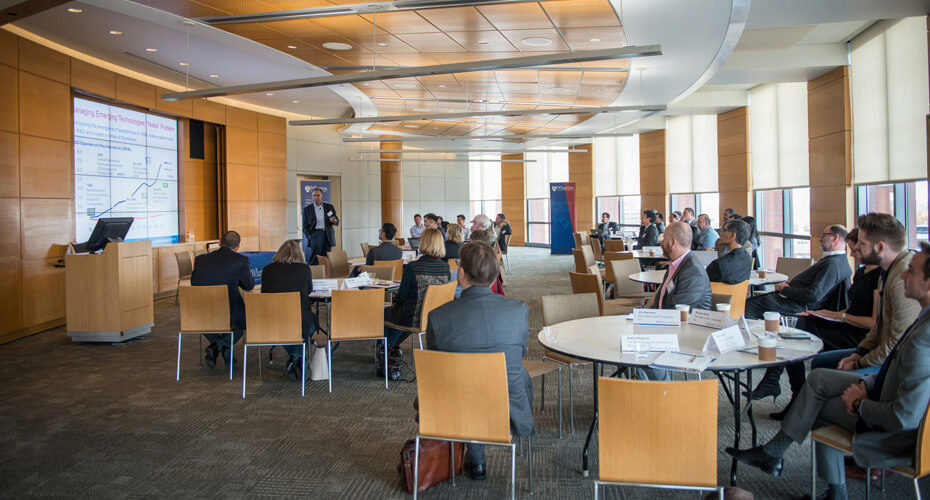“Has anyone ever seen a young kid, like a 2-year-old, walk up to a TV screen and try to swipe it?” asked Justin Reilly, head of customer experience innovation at Verizon Fios. Many audience members chuckled and nodded in recognition. Reilly imagined aloud what the baffled toddler might be thinking: “What is this junk? I’ve got to get a new TV.”
New customers (or in the case of the 2-year-old, very new), cutting-edge innovations, and emerging threats and opportunities are rushing with lightning speed toward today’s businesses. Firms have their hands full. But as a result, they often they don’t pay enough attention to the critical importance of strong strategic leadership, according to Mack Institute executive director Saikat Chaudhuri. Chaudhuri introduced the Mack Institute Fall Conference 2017: “Emerging Innovation Leadership Challenges for Global Firms.”
“[Business executives] get really into the strategy and other organizational aspects, and into the technology, of course,” said Chaudhuri. But leading and aligning technology strategy in an organization is an essential skill, one that companies absolutely must have to succeed. And it goes beyond just charisma or leadership vision, he noted.
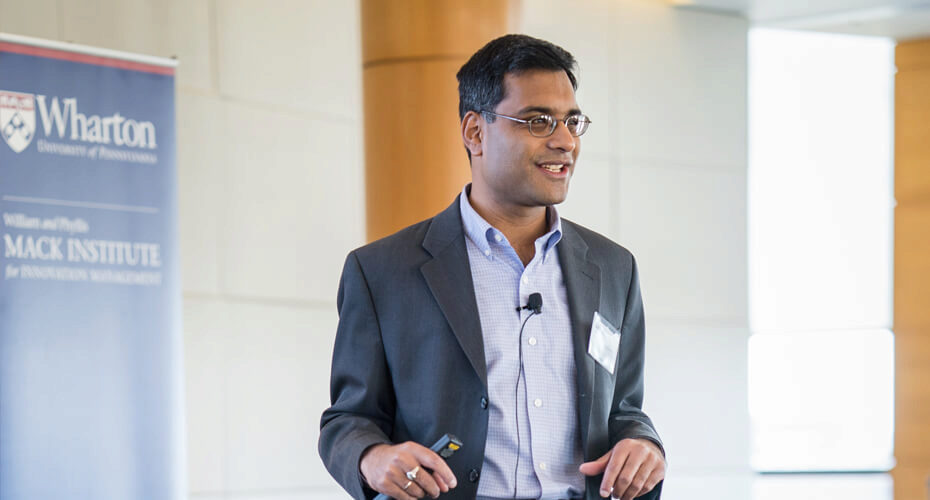
He asked the participants to consider questions such as, What are the hallmarks of a good strategy? What are the hallmarks of good organizational leadership? And, what does it mean to effectively link strategy and execution?
Leading with New Technologies, Understanding New Customers
The late Steve Jobs once spoke in a documentary about his 1970s visit to the then-monolithic Xerox company offices. He disparagingly referred to the executives as “copier heads” and said they “just had no clue about what a computer could do.” Why did Wharton management professor Rahul Kapoor show this clip? To illustrate what he called the “Xerox Problem.”
The problem is that an established company’s engineers may well develop bold new technologies (in Xerox’s case, it was the graphical user interface we now take for granted in computing). But if it doesn’t fit with the company’s familiar business model, the C-suite won’t take it to market. Kapoor said companies can miss out hugely as a result of this incumbent inertia, or organizational inertia.
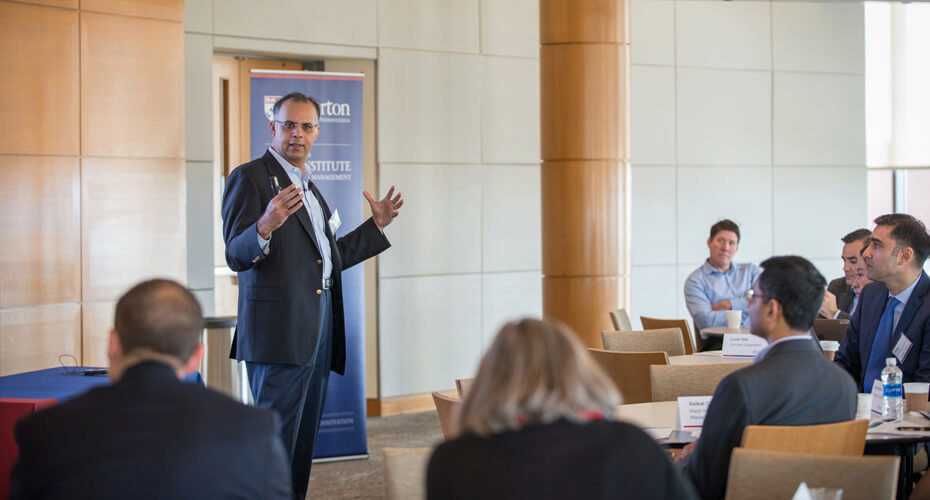
He tracked the problem in more contemporary examples. For instance, in the pharmaceutical industry, two innovations are emerging simultaneously: monoclonal antibodies (mAB) and gene therapy. With mAB, he said, the innovation fits with the prescription-based business model that pharma companies are used to. Not so with gene therapy, which involves personalized medicine, a whole new approach to treating patients.
As a result, gene therapy is progressing much more slowly. “The same inertia we saw with Xerox is now showing up in the pharmaceutical companies,” said Kapoor.
Kapoor identified a second type of innovation problem, the “Nokia Problem.” Years ago, Nokia invested heavily in mobile phones with computing features (now disparagingly referred to as “dumbphones” since all they could do was call and text), but the company eventually took a nose dive because it never engaged with the idea of apps. “The app ecosystem was not part of their value creation, and they got disrupted by both Apple and Google,” he said. He emphasized that leaders must keep an eye on the broader ecosystem surrounding their firms’ innovations.
Kapoor said that in order to overcome organizational inertia, leaders may want to create a structurally separate organization when working on an important new innovation. He cited the way Google created Alphabet, a collection of companies to focus on innovations like autonomous vehicles and smart homes.
The next speaker was Reilly, who began by describing how a friend’s five-year-old son recently had tried to talk to the family’s Alexa device while at the park. When the father explained that “Alexa wasn’t there,” the little boy replied, “I know, but she will be someday soon.”

To Reilly, this is more than just a funny parenting story. It suggests how Generation Z is thinking about tech at a very young age and how they’ll interact with brands going forward: through voice, touch, and swipe instead of keyboards. He noted that Gen Z indexes very high on a scale of technology early adopters.
He presented some startling facts about Gen Z that he said many executives don’t pay enough attention to because they’re focused on millennials. Gen Z now has a global annual purchasing power of $44 billion, and a global annual influencing power of $200 billion. And by 2020 they will constitute a third of the world’s population.
With this new customer base in mind, Reilly said, Verizon aims to provide a distributed experience: taking all the ways the customer interacts with the brand, and delivering them to the places that customers already are. The first iteration of this is the Fios Messenger Bot, accessed through Facebook Messenger. The bot does things like recommend what shows to watch, answer questions about what your cable package includes, troubleshoot technical problems, update you when a repair person is en route, and enable bill payment.
Reilly concluded by identifying some innovation strategies he said have worked well for Verizon, including to build nimble teams, productize the organization, incentivize failure, and co-create with customers. He said he always keeps in mind that “we’re only as good as our customers’ last, best experience.”

Regulation: A Looming Concern for Strategic Leaders
“Understanding the linkages between innovation and regulation is a critical issue these days,” said Michael Mandel, Chief Economic Strategist at the Progressive Policy Institute. He discussed some considerations for strategic business leaders.
Mandel said that since 2000, the number of regulatory jobs in the U.S. has increased by almost 60%, with FDA jobs going up more than 100%. Are all these regulators trying to catch up with fast-moving innovative companies, Mandel asked, or are business innovators being stymied by too much regulation?
He compared regulations to pebbles thrown into a stream. Toss in one or two and nothing happens, but throw in hundreds and the stream will get dammed up. “It’s pretty clear that any particular regulation—aside from the most egregious—businesses can deal with,” Mandel continued. “But when you put in another and another one, all of a sudden you’ve generated a business which is more concerned with compliance than with innovation.”

Mandel spoke about how regulatory and innovation models vary in different parts of the world. He said the U.S. tends to be reactive, instituting regulations only after problems occur (such as after the Great Recession). But in Europe there’s a mindset of regulating before problems occur. He cited widespread objections to GMOs, and some cities’ banning of Uber. “[In Europe] you have to prove that an innovation is not going to do harm… There’s a much higher hurdle.”
China’s regulatory model, on the other hand, features heavy state involvement in monitoring and directing innovation. Mandel noted that in the case of China’s massive push in artificial intelligence, this approach has been successful.
Overall, keeping an eye on worldwide regulatory strategies will yield valuable information, said Mandel. “Because these different regulatory models are creating a natural experiment, we’re going to understand a lot more over the next five to ten years about the impact of regulation on innovation.”
Integrating Leadership and Strategy
Successful strategic leadership was reflected in the talk by Nihar Shah, vice president of strategy and market intelligence for SES (Société Européenne des Satellites). SES is the world’s largest satellite communications operator. “If you’ve ever watched television in the U.S., or ever been to Europe… to the U.K. and watched television, I could pretty much bet that those television signals were delivered on our satellite system.”
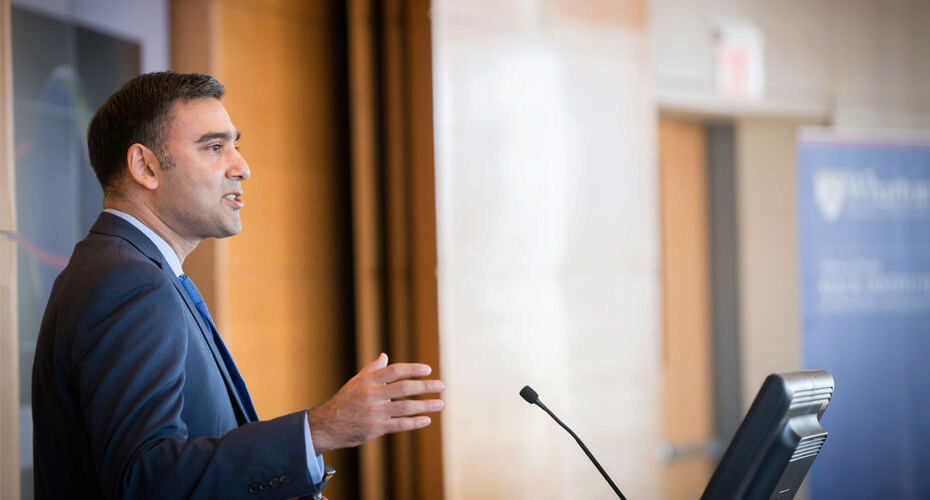
Shah described how in 2005 when SES was already Europe’s biggest satellite operator, it encountered what he called “a very serious long term threat and risk” to the business: video could now be viewed on the internet, for example on YouTube. In addition, smartphones were emerging, and people were demanding more bandwidth than satellite communications could deliver with the current state of technology.
Increasingly, SES recognized problems with satellite’s cost, latency, scalability, and profitability. And the user experience was sub-optimal. “You’d put something in your Amazon cart and hit Purchase and it would time out,” he said, or you’d try to Skype with your mom in China but your voices were too out of sync.
SES decided to look externally for a solution. It found one in a startup called O3b Networks that had a small Series A investment from Google Ventures. O3b had an innovative plan for a group of small satellites positioned closer to the Earth (known as MEOs, or Medium-Earth Orbit). The new technology promised more flexible coverage of more countries, a 60% improvement in network performance, better scalability, and a much lower cost.
The technology was unproven and SES’s engineers were initially very skeptical, but company leaders moved forward anyway. Shah explained, “We came from a defensive position where we were a bit player in the market. So we wanted to come in with something so differentiated that it would essentially blow everybody else out of the water.”
SES was prepared to take some risk to make that happen. The company took a minority stake in O3b in 2008, increasing its stake over the next several years. This year it took 100% control, while still preserving, to a large extent, the identity of O3b within its corporate structure. The project has been extremely successful. Among other achievements, SES has been able to bring connectivity to many remote Pacific islands, to the world’s largest cruise ship, and to overseas U.S. military locations, among others.
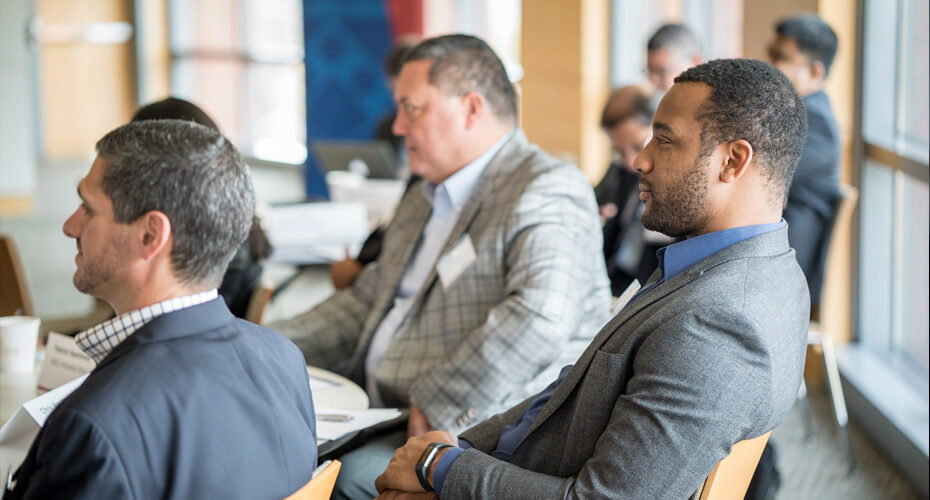
Shah said that to him the most important thing about integrating leadership and strategy is to have humility. For example, SES didn’t have the arrogance to think that just because it was the industry leader it could invent everything by itself. And it resisted imposing its culture and processes on O3b, instead “letting them bloom.” Shah added, “I think the results speak for themselves.”
Addressing strategic leadership from a different perspective was Jeffrey Blander, Chief Innovation Officer at the Global Office of Health Diplomacy of the U.S. State Department, Presidents Emergency Plan for AIDS Relief (PEPFAR). Dr. Blander began with a quip that some business leaders who hear “government” and “innovation” may think of that as a contradiction in terms. But in reality, government can be an extremely valuable partner to advance innovation and expand opportunities for businesses in new or emerging markets.
PEPFAR, started in 2003 by then-president George W. Bush, is a bi-partisan effort to combat and end HIV/AIDS globally. The program has made significant progress since its start. Referencing the recent annual report to congress, PEPFAR supports nearly 11.5 million people with life-saving antiretroviral treatment, a 50 percent increase since 2014 and up from the fewer than 50,000 people who were on treatment in sub-Saharan Africa when PEPFAR began. Dr. Blander noted, “It’s an example of how government, working in collaboration with our partners, can do things extremely well when it’s focused, and data- and mission-driven.”
He talked about the strategic rigor that PEPFAR exercises when making targeted investments for innovation and how it is comparable to the level of business strategy in for-profit organizations. Said Blander, “Specific to program oversight and accountability, we’re continuously thinking, how do we get better bang for our taxpayer dollar… It’s not about being satisfied with our successes, it’s about how do we create and incentivize high impact, innovative solutions so that we can get even greater value for our investments.”
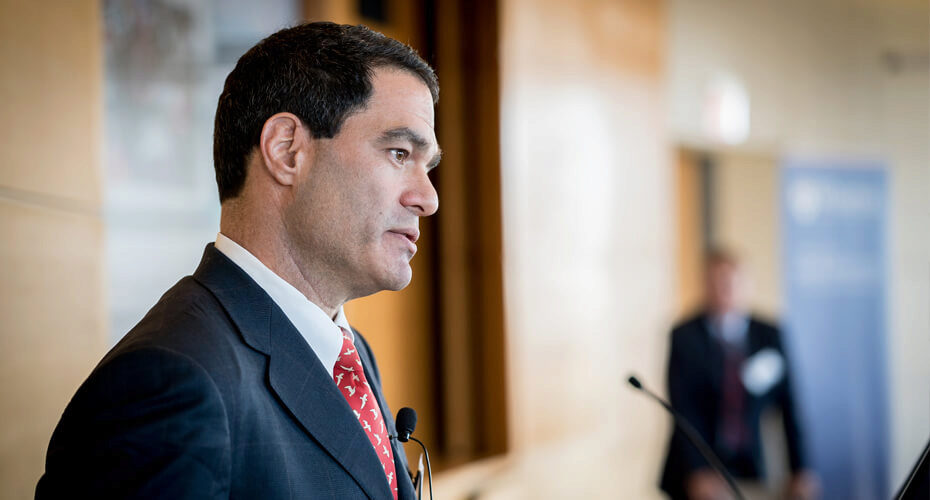
He added that PEPFAR performs quality improvement through real-time program monitoring. This takes place across the 35 country and regional operating units globally, by population, geography, and implementation partner to enable strategic course correction as well as targeted interventions. “The data is entered continuously at the sites we support so we can learn how we can do better.”
Blander encouraged the attendees to consider public-private partnerships as part of their strategy to achieve their innovation goals. He talked about some of the opportunities PEPFAR offered for the future, saying, “We’ve made a lot of progress, but our work is far from done.”
Seeing Sooner and Acting Faster
Wharton emeritus professor George Day began the conference workshop “See Sooner/Act Faster: The Role of Vigilant Leadership” with a quotation from legendary CEO Jack Welch: “Leaders must develop a sixth sense, an ability to see around the corner.”
Day said that most leaders are good at focusing on the next quarter’s results and on the moves and countermoves of direct competitors. Yet key information may hover just outside their immediate attention. By recognizing emerging threats and opportunities sooner, he said, the organization gains more degrees of freedom to act—not just react.
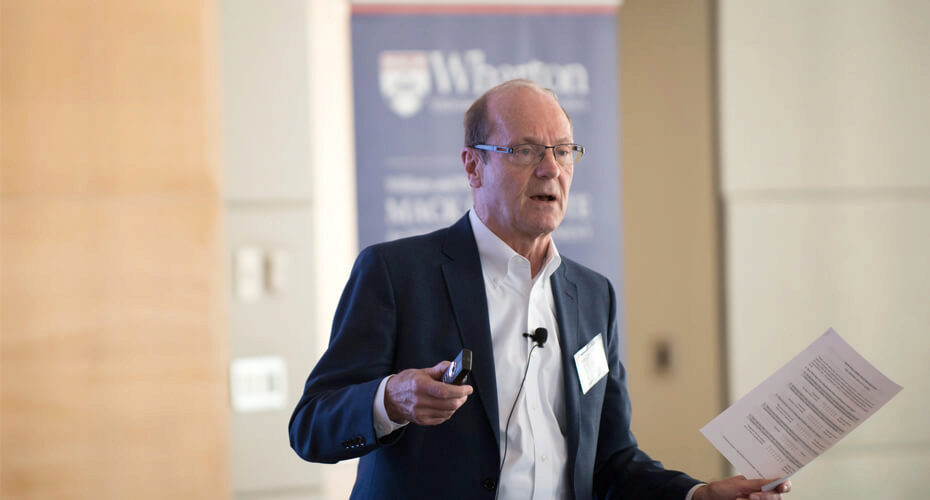
He referenced companies that had “seen sooner,” such as Adobe, which turned a looming threat to Photoshop into an advantage for itself; and Nike, which had made itself a leader in online customer engagement. However, said Day, “we have many more examples of companies that missed the boat.” Consider, he said, how Microsoft came too late to smartphones and only has about 2% of that market.
Through an innovation exercise, Day helped participants think about how their companies can improve vigilance and become more attuned to “weak signals” in the market. Participants shared and analyzed examples of times they felt their firm was slow to detect a threat or seize an emerging opportunity.
An executive from a large cosmetics company described how his company was traditionally involved with selling through a department-store business model. In his view, the leadership was caught off guard by the strong growth of specialty cosmetics stores like Sephora and Ulta. The company has had to “drastically change the way we do things,” he said, including how it handles product lifecycles, product releases, the arrangement of products in the store, and sales relationships. In addition, the fact that the firm had not “seen sooner” unfortunately allowed new, smaller new competitors to enter the space.
Another participant, this one from an industrial supply distributor which services mostly business-to-business manufacturers, described how a competitor had decided to sell small tools via vending machines placed in customers’ facilities. His company resisted doing the same at first, not wanting to incur the capital expenditure, and was late to the game by the time the vending machines proved successful for their competitor. Soon the competitor was already on to a new, even more innovative solution. The lesson, said the participant, was “Let’s protect what we can protect, but let’s [always] look forward to where the puck is going to go next.”

In other reports, a participant shared how her company had been slow to recognize how much its workforce was aging, and now had to scramble to attract millennials. Another attendee described how his bank, located in India, had to play catch-up with financial technologies and training after India’s economy was opened and there was an influx of tech-savvy foreign banks.
Day discussed many ways that business leaders could improve their ability to see farther and act faster. One was to focus on recognizing anomalies, such as a competitive move you don’t understand or an unexplained shift in customer base. Another was to analyze fast-growing competitors at the periphery of the field: to ask yourself, “What are they up to, and where are they going to be in three years if they keep it up?” Day commented that this kind of analysis could be a rich source of insights into those weak, but critical, market signals.
The Mack Institute’s Chaudhuri closed the conference, announcing the next conference which will take place in San Francisco in May. He framed the day’s very interdisciplinary discussions by observing that one theme which had arisen again and again was the idea of partnerships.
“We live in a world where technology regulations, globalization, conditions, all these things change too fast. We can’t do everything ourselves… we need to look outside the organization as much as internally.”
